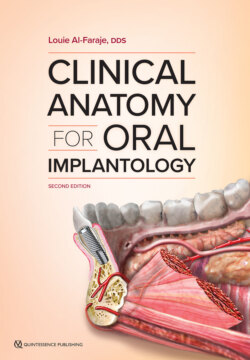Читать книгу Clinical Anatomy for Oral Implantology - Louie Al-Faraje - Страница 17
На сайте Литреса книга снята с продажи.
Trigeminal Nerve
ОглавлениеThe 12 cranial nerves control motor and sensory functions of the head and neck. Figure 1-10 and Table 1-2 summarize the skull base foramina from which these nerves exit the skull and their functions.
FIG 1-10 The origin of the cranial nerves as seen from an inferior aspect of the brain. n.—nerve.
TABLE 1-2 Exit foramina and functions of the cranial nerves
| Nerve | Name | Skull base foramina | Functions |
| I | Olfactory | Cribriform plate | Sensory for smell |
| II | Optic | Optic canal | Sensory for vision |
| III | Oculomotor | Superior orbital fissure | Motor for six eye muscles |
| IV | Trachlear | Superior orbital fissure | Motor for one eye muscle |
| V1 | Trigeminal/ophthalmic division | Superior orbital fissure | Sensory for lacrimal gland, nearby air sinuses, scalp, forehead, upper eyelid, and nose |
| V2 | Trigeminal/maxillary division | Foramen rotundum | Sensory for parts of the nasal and oral cavities and the skin of the cheek and upper lip |
| V3 | Trigeminal/mandibular division | Foramen ovale | Sensory for the skin over the mandible, lower lip, temporal region, and much of the oral cavityMotor for muscles of mastication as well as the anterior belly of the digastric muscle, mylohyoid muscle, tensor tympani, and tensor veli palatine muscles |
| VI | Abducens | Superior orbital fissure | Motor for one eye muscle |
| VII | Facial | Internal auditory meatus | Motor for muscles of facial expression, stapidius, and posterior belly of the digastric muscle; also motor for the lacrimal glands, oral and nasal mucosa, and submandibular and sublingual glandsSensory for the external auditory meatus; lateral pinna; mastoid; mucosa of the pharynx, nose, and palate; as well as sensory for taste for the anterior two-thirds of the tongue via the chorda tympani |
| VIII | Vestibulocochlear | Internal auditory meatus | Sensory for balance and hearing |
| IX | Glossopharyngeal | Jugular foramen | Motor for the stylopharyngeus muscle and parotid glandSensory for the posterior external ear, tragus, posterior third of the tongue, soft palate, nasopharynx, tympanic membrane, Eustachian tube, and mastoid region and sensory for taste for the posterior third of the tongue |
| X | Vagus | Jugular foramen | Motor for the pharyngeal and laryngeal muscles, including the palatoglossus muscle; also motor to the smooth muscles and glands of the pharynx, larynx, heart, esophagus, and stomachSensory for the ear, external auditory meatus, external surface of the tympanic membrane, dura of posterior cranial fossa, larynx, lungs, heart, esophagus, and stomach |
| XI | Spinal accessory | Jugular foramen | Motor for the sternocleidomastoid and trapezius muscles |
| XII | Hypoglossal | Hypoglossal canal | Motor for all intrinsic tongue muscles and all extrinsic tongue muscles except the palatoglossus muscle (innervated by CN X) |
